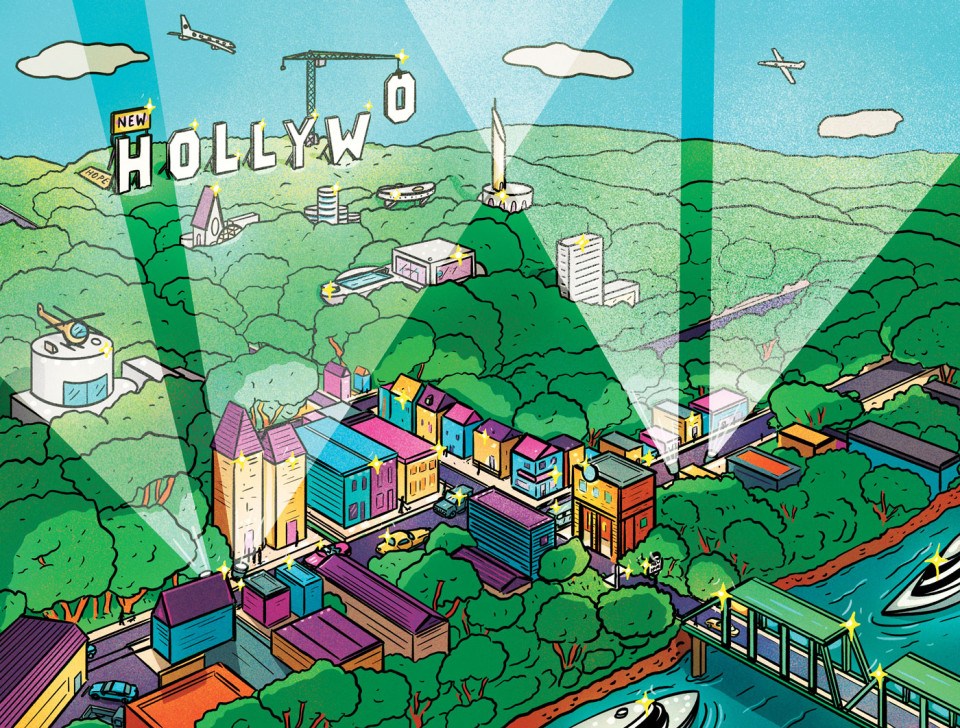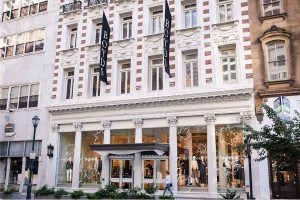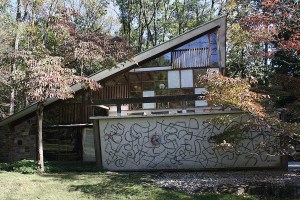The New Face of New Hope: How a Small Bucks County Town Became a Playground for the Rich and Famous
Bradley Cooper. Leonardo DiCaprio. Gigi Hadid. Can the borough’s bohemian spirit survive an A-list invasion?

The New New Hope / Illustration by Laurent Hrybyk
One evening, as I drove down Main Street in New Hope, I passed three high-end restaurants, two boutique hotels, a Chelsea Market-style suite of trendy food stalls, and a bustling entertainment complex on the riverfront embellished with cafe lights. I was heading toward River House at Odette’s, a recently constructed luxury hotel; when I pulled up to the valet stand, the exterior of which threw out urban-chic-meets-covered-bridge vibes, I noted the Range Rovers, Mercedes G-Wagons, and Porsche Cayennes parked in the lot. When I was buzzed up to the private rooftop deck and bar, the doors opened to reveal a posh crowd chatting over drinks, sporting wealth-whispering neutral-toned blazers and blouses and toting designer bags worth more than the average American’s mortgage payment.
Surveying the scene, I thought to myself: This is not the New Hope I grew up with.
Everyone knows of places like Aspen, Palm Beach, and the Hamptons — glamorous retreats where elites park their money and enjoy an exclusive escape that only their affluence provides access to. As snarled traffic and burgeoning crowds have tarnished some of the shine of these communities, these jet-set folks have been searching for an alternative — under the radar, but still maintaining that aura of stealth wealth, where their expensive tastes will be catered to and the locals will take their presence in stride.
They seem to have found what they’re looking for in a spot halfway between Philadelphia and New York: two sister towns straddling the Delaware River, one in Pennsylvania and one in New Jersey. These Loro Piana-clad pioneers are heading to New Hope and Lambertville to buy real estate and hide away in the relative anonymity of the towns’ cafes, bookstores, and vintage and antique shops.
“I have a billionaire client who wants to bring his family here. They are buying a new build right outside the borough [of New Hope],” says Revi Haviv, a realtor for Addison Wolfe, a broker that specializes in high-end properties in New Hope and the surrounding areas in Pennsylvania and New Jersey. “Everyone knows that the Hadids live here, and that Bradley Cooper just bought a house here. Owners of riverfront property can name any price they want. And this is only the beginning.”
While the New Hope-Solebury market in Bucks County has always been competitive due to its highly rated schools and low taxes, recent Bright MLS data tells the story of its increasing popularity among individuals and families with deep pockets. In the 2020-’21 sales cycle, 32 homes sold for more than $1.5 million. In just the first five months of 2024, that number was 46. Even in Lambertville, widely regarded as the more affordable of the two boroughs, an attached four-bedroom on a desirable street will fetch nearly $1 million, double the price of a few years ago.
Bradley Cooper is the most recent new resident, on his $6.5 million bucolic estate in New Hope. He joins the Hadid family (Gigi, Bella, and Yolanda), author James McBride, One Direction’s Zayn Malik, Bob Dylan’s son Jakob Dylan (of the Wallflowers), and numerous other artists, Fortune 500 execs, and nepo-babies. Other big names from Hollywood have also descended on the area; recent celebrity sightings on the streets include Leonardo DiCaprio and Hailey and Justin Bieber. This past June, Apple Studios was in Lambertville shooting Echo Valley, a movie starring Julianne Moore and Sydney Sweeney.
Local tourism mirrors the real estate boom. On any given weekend, masses of visitors cross the New Hope-Lambertville bridge, wander into the shops and galleries, and pack restaurants in the towns’ commercial districts. Since 2020, three new luxury hotels have come on to the scene and another was extensively remodeled, with suites going for $400 to $1,000 a night, and investors have purchased downtown properties and transformed them into high-end short-term rentals. Three years ago, a search on Airbnb would turn up three or four uninspiring listings. Over the summer, there were 94 rentals available for a long weekend in July.
Today’s renaissance, however, comes after decades of decline. In the early aughts, the vibe was more Wildwood boardwalk than Beverly Hills. The Bucks County Playhouse was bankrupt and dilapidated, the local economy seemed to consist mostly of head shops and dive bars, and Lambertville was colloquially known as “that town across the river.” Now the Playhouse is the triumphant centerpiece of a revival along the Delaware that has attracted developers, homebuyers, shoppers, and tourists.
Haviv, the realtor, is also a business owner in New Hope. Her designer store, Savioni Boutique, has been perched at the corner of Bridge and Main for the past 20 years. Her receipts bear witness to the dramatic rise in the towns’ popularity among wealthy elites: Her business has quadrupled since 2021, she says, growing each year.
The richies moved in because it was an awesome, artsy town, and have destroyed almost everything that made this town amazing.” — Meshell Kimbel
“The tourists that are coming have more money,” she adds. “They think nothing of spending $800 a night at Odette’s, $1,500 on a Savioni jacket, or $400 on dinner.”
Not all New Hope residents are thrilled with the rich people taking over their town. Many locals lament the days when you could both live and work in the borough, attend a punk show at Club Zadar, and stay up all night drinking coffee at the New Hope Eagle Diner. “The richies moved in because it was an awesome, artsy town, and have destroyed almost everything that made this town amazing,” Meshell Kimbel, who owns the punk-rock-themed shop God Save the Qweens on Mechanic Street, said in a recent Facebook discussion. “I’m still here after 17 years; however, they will eventually get rid of me too — but there will be a lovely condo you can buy for two mil.” (To her point, a block of $2 million condos recently popped up across the street from her building.)
“My dad always said that once you’ve lived in New Hope for five years, you are allowed to bitch about how New Hope used to be,” chuckles Rick Rosen, son of the late Bucks County and celebrity photographer Jack Rosen. A longtime resident and musician, Rick has witnessed the rapid evolution of Main Street and had to relocate outside of the historic district when his landlord decided to sell.
How did this sleepy, quaint location that looks like it was lifted from an episode of Gilmore Girls suddenly become a swish new hot spot for society’s upper crust? And can “the richies” and regular townsfolk coexist, or is this yet another instance of a quirky community losing its soul to commercialization? Diving into the past provides some answers — and some optimism.
History is vital to the spirit of New Hope and Lambertville, known collectively as Coryell’s Ferry in the 1700s and early 1800s. Both towns have active volunteer-run historical societies, and it is not unusual to see a National Register of Historic Places plaque affixed to a neighbor’s front door. Civil War-era churches, firehouses, factories, and barns dot the landscape, a reminder of previous iterations of these two municipalities. The towpath along the Delaware Canal, which was used to transport coal and other goods up and down the river during the Industrial Revolution, is now a popular running, walking, and biking path for visitors and residents alike.
“In the early 1900s, Impressionists came down from New York and brought with them other artists, musicians, and actors,” says John Danaher, a New Hope resident, touring musician, and local historian. “The Bucks County Playhouse was built in 1939, one of five in the region that were ‘summer stock,’ so Broadway plays would be worked out there. That was also part of what brought the artistic element: theater, music, and writing. A lot of famous people came to New Hope as a result.” Liza Minelli, Robert Redford, Kevin Kline, and Rob Reiner are among the Hollywood royalty who have graced the Playhouse stage over the years.
After decades as a boisterous hub for highbrow art and culture in the 1940s, ’50s, and ’60s — around the time inns such as the Hacienda attracted famous guests like Burt Reynolds, Liberace, and Ella Fitzgerald — both the Playhouse and New Hope entered a period of decline. Thanks to the proliferation of air-conditioning in the 1970s, Broadway no longer needed to shut down for summer — and so no longer needed the summer stock theaters. Financial issues plagued the Playhouse for decades and culminated in bankruptcy proceedings in 2010, with other New Hope institutions following suit.
The namesake of River House, Chez Odette, was a popular French restaurant and cabaret owned by film and stage actress Odette Myrtil that served as the heart of New Hope nightlife for decades. Odette’s closed permanently after successive floods during the mid-2000s and sat dilapidated and vacant until an investment group purchased the property in 2013. Originally an inn, general store, and tavern built in 1794, the structure held deep significance for New Hope but was not part of the redevelopment plans for the site. Danaher’s brother-in-law Tom Lynch, a partner in the investment group behind the contemporary incarnation of Odette’s and a Bucks County native, paid out of his own pocket to save the historic building and relocated it to the south entrance of the borough in 2018 to make way for the new hotel.
Simultaneously, a dining and lodging complex began sprouting up around the Playhouse, fueled by the millions invested by new owners Kevin and Sherri Daugherty of Bridge Street Foundation. In 2017 they launched Ferry Market, a hub of upscale vendors that includes a craft brewery, a coffee bar, and a confectionery. The Ghostlight Inn opened in 2019 after an eight-year restoration at the site of an abandoned nightclub.
Others then began joining the revival taking place in New Hope. In 2019, Jose Garces opened Stella adjacent to the Playhouse, right on the banks of the Delaware. (Garces sold Stella in 2021 to another restaurateur.) In the intervening two years, Landmark Hospitality carried out a large-scale renovation of the storied Logan Inn, as well as the Mansion Inn next door, completing the transformation of downtown New Hope.
“All of these developers and businesspeople are supportive of each other, but there was no master plan,” says Danaher. The revival happened organically, fueled by independent partners who believed that New Hope could regain its reputation as a place where people could come for art, for food, and for beauty.
Strolling across the steel-truss New Hope-Lambertville bridge, one can appreciate why New Yorkers, Angelenos, and other urban dwellers are flocking here seeking refuge. The bucolic scene of church steeples poking above a cluster of historic residences perched on the banks of the river, hugged by lush green hills, is in stark contrast to the concrete sprawl and anxious energy of the coastal cities from which they are retreating.
While the natural beauty and the charming towns are certainly a draw for wealthy tourists and buyers, there may be other factors — economic, familial, even spiritual — that attract them to New Hope and Lambertville.
The pandemic really brought forth so many things personally and societally, and just having a place where you can decompress was really important.” — Darius de Haas
“Artists need a place where we have quiet, where we can refill our cup. Sometimes when you are surrounded by noise and you are always going, going, going, it’s easy to get lost in the busyness of that,” says Darius de Haas, a Broadway actor who, along with his husband, Kyle Rudy, discovered the area more than 20 years ago when friends offered their cottage for the weekend.
While living in New York full time, de Haas and Rudy purchased a home locally and became “weekenders.” Their priorities shifted during the pandemic, and they decided to make Lambertville their permanent residence, falling in love with an elegant 1860 Victorian on Union Street that was once owned by a railroad superintendent. They converted the multifamily home back to a single-family, undertaking a renovation that retained the original crown molding, floor-to-ceiling pocket doors, and parquet floors.
“We had a beautiful apartment in New York, which I thought we would never leave. But there was something in me that said, You are ready to let this go,” de Haas says. “The pandemic really brought forth so many things personally and societally, and just having a place where you can decompress was really important.”
Cressey Belden is a Princeton alum who has lived in Los Angeles, New York, and Northampton, Massachusetts, but circled back to New Hope to be closer to her alma mater after her adult child flew the nest. After her exhaustive search to find the right place to live, which included proximity to Princeton and New York, New Hope and Lambertville just felt right. “People come here for peace. They come here seeking a respite from the world,” Belden says.
Most of the locals I spoke with for this story were nonchalant about celebrities and Fortune 500 executives living in their town and were coy when asked if they’d encountered any. It’s the reason high-profile people like it here: Bella Hadid can score some stylish threads at a vintage clothing store and no one will bother her, while mom Yolanda can go shopping down the street at Soulberry Market and bag her own groceries. Zayn Malik can find inspiration for his next album while hunkering down in relative solitude at his New Hope abode. Jakob Dylan can get involved in the community and join an arts advisory meeting at New Hope-Solebury High School. And Bradley Cooper can have an omelet at Hash House in Lambertville without someone blowing up his spot.
These newcomers have discovered the soul-cleansing properties that a retreat to the banks of the Delaware River brings. But some New Hope and Lambertville natives worry that this peace will soon be available only to those who can afford it.
When I was a teenager in the Philadelphia suburbs in the late ’90s and early 2000s, New Hope was a haven for my fishnet-stockinged and spiked choker-wearing friends. We could rock out to punk music, wander around the candy stores, and giggle at the sex-toy shops without getting side-eye from the locals. It was artsy and gritty, and it felt like a safe space for modestly successful creatives, dreadlocked hippies, leather-clad bikers, and Warped Tour devotees. My Millennial posse was the beneficiary of a version of New Hope that had formed decades prior to our arrival.
While the 1980s and ’90s were a time of financial distress for many local businesses, the bar and club scene thrived, drawing in the LGBTQ community and those living an alternative, bohemian lifestyle. Facing stigma from the outside world, queer people flocked to gay bars like the Raven and the Cartwheel, where they could feel secure and comfortable and have fun. Most of that scene is now gone, although New Hope and Lambertville remain a magnet for LGBTQ visitors and homebuyers.
Club Zadar was popular among fans of post-punk and new-wave music. Although Zadar closed in 2001, it was beloved enough that former DJs, musicians, and patrons of the club created a very active Facebook page where more than 900 members stay connected and share memories. When I reached out to them to ask their opinion of the changes in New Hope over the past few years, responses were overwhelmingly negative. Almost unanimously, they missed the eclectic community that existed in the 1980s and ’90s and railed against the multimillion-dollar new builds cropping up in town.
Donna Ripley spent her youth in downtown New Hope during the heyday of Zadar and now works at the gourmet grocery store Soulberry Market, where the Hadids and Jakob Dylan often shop. She’s disappointed that New Hope’s once-gritty charm has all but disappeared: The Raven was razed to become a parking lot for River House at Odette’s, and beloved eateries like Fred’s Breakfast Club have closed. There are plans for yet another high-end development project on North Main Street at the site of the Landing restaurant that have locals up in arms, while a few lots down, old riverfront properties are being replaced by boxy, Selling Sunset-style châteaus.
Developers, she says, are knocking down historic homes along the river and replacing them with Hamptons-esque mega-mansions, blocking the Delaware (and the view) from the rest of the town. “I see the New York plates all the time, especially since COVID,” she says. “[New Hope] is being ruined.” For Ripley and other longtime residents, it feels as though the New Hope and Lambertville represented by avant-garde shops like God Save the Qweens is slipping through their fingers.
But these towns have been through this before: changing with the times, rising and falling in popularity, hosting fancy people and then becoming an afterthought, only to draw them back in again. You only need to hearken back to when Odette Myrtil turned a stuffy general store and tavern geared toward canal workers into a roaring nightclub. It’s coming full circle again.
“Things have definitely exploded in the last few years, but it’s been coming,” says Rick Rosen. “Paul Simon had a house here at one point. [So did] Oscar Hammerstein. There’s a tradition of this.”
Most of the investors and developers responsible for the recent changes in New Hope and Lambertville have roots in the community, understand the history, and want the area to flourish. When a property needs renovation, historical restorationists are often consulted. When a place needs to be torn down, artifacts are preserved. When new people move in, they join historical societies and arts and community organizations.
Not all change is bad change. We can let these buildings rot, or let people use creative vision to improve our future here. A property from the 1700s is not going to make it on its own.” — Revi Haviv
Tom Lyon is a retired physician who moved from Philadelphia to New Hope eight years ago with his partner, purchasing Odette Myrtil’s former residence. They were drawn in by the arts community and the history of the town, and Lyon currently volunteers with the historical society. “If that [change] is what it takes to remain economically viable, then that’s what it takes. I don’t want things to stand still if that will make us less successful,” he says.
“Not all change is bad change,” says Revi Haviv, the real estate agent and business owner. “We can let these buildings rot, or let people use creative vision to improve our future here. A property from the 1700s is not going to make it on its own.”
And some of the places that make New Hope and Lambertville special endure. Bucks County’s oldest independent bookshop, Farley’s, was purchased by store employees, renovated, and reopened in 2023. The nonprofit New Hope Arts supports and features local artists; its exhibit space got a facelift last year. Post-COVID, two new coffee shops opened in Lambertville and were immediately swarmed by locals and tourists alike desperate for an alternative to Starbucks. Like they have for more than 300 years, New Hope and Lambertville will evolve — and ultimately thrive.
“The change was going to happen anyway, but when I walk around, New Hope is still New Hope,” says Rosen.
Published as “The New New Hope” in the October 2024 issue of Philadelphia magazine.


